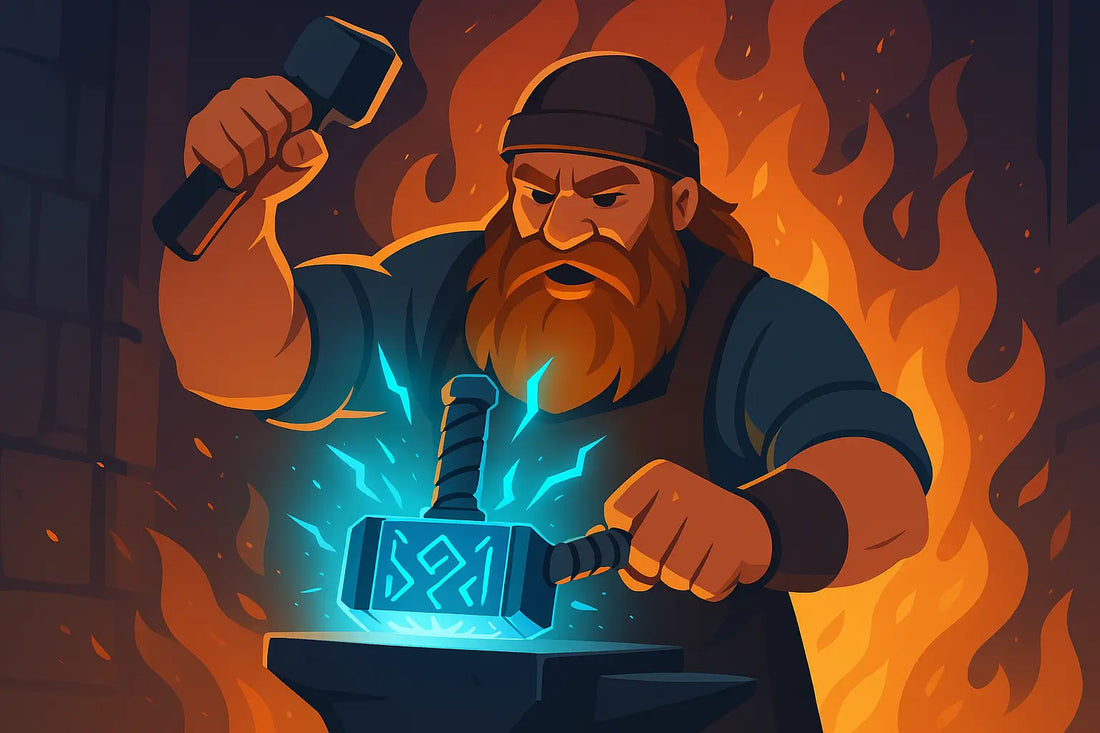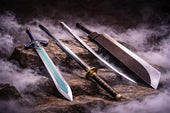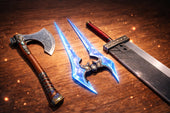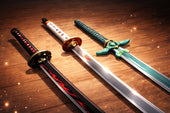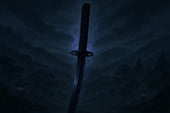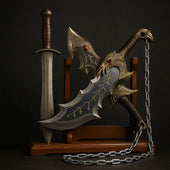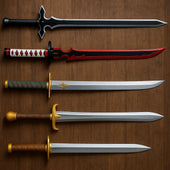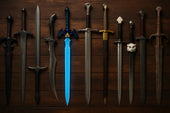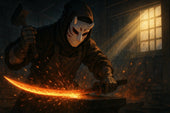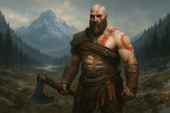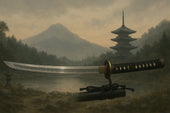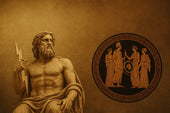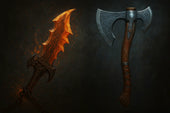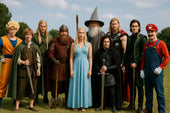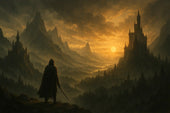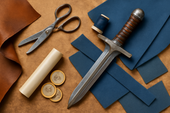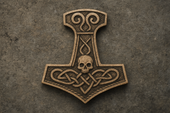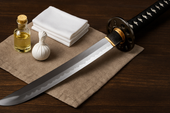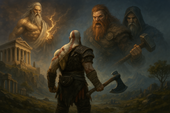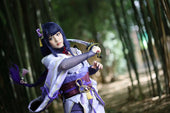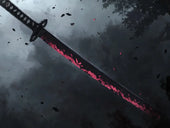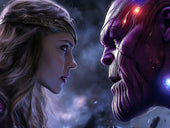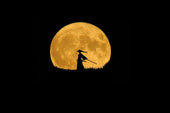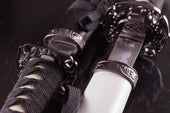Few weapons in mythology hold as much power and prestige as Mjölnir, the legendary hammer wielded by Thor, Norse god of thunder. Known for its thunderous might, ability to return to its master, and symbolism of divine protection, Mjölnir is more than just a mythological artefact—it is a cultural icon that has endured across centuries, from Viking Age amulets to modern-day pop culture.
But how was this mythical hammer created? Who forged Mjölnir, and why is it considered one of the greatest treasures of the gods? The story of its origin is one of mischief, magical craftsmanship, and unexpected consequences.
Mjölnir, Thor’s legendary hammer, was forged by dwarves after a trick by Loki set events in motion. Despite a flawed handle, it became the gods’ most powerful weapon—symbolising protection, blessing, and divine strength in Norse mythology.
Let’s delve into the creation of Mjölnir and explore how one of Norse mythology’s most powerful weapons came to be.
Mjölnir in Norse Mythology: More Than Just a Hammer
Before exploring its origin, it’s worth understanding what Thor’s Norse Mjölnir represents within the mythology.
Mjölnir (pronounced MYOL-neer) wasn’t merely a tool of destruction. Though it was used by Thor to smash giants and protect Asgard and Midgard, it also had sacred roles—used in blessings, weddings, and births. Its powers included:
-
Returning to Thor’s hand after being thrown.
-
Channeling lightning and thunder.
-
Being unbreakable.
-
Shrinking small enough to be hidden in Thor’s tunic.
It was a divine object that embodied strength, protection, and fertility, deeply embedded in Norse religious practice and Viking symbolism.
Loki’s Mischief: The Catalyst for Mjölnir’s Creation
As with many myths, the creation of Mjölnir began with a trickster’s mistake. Loki, the cunning and chaotic Norse god, played a prank that went too far: he cut off the golden hair of Sif, Thor’s wife.
When Thor discovered what had happened, he threatened Loki with dire consequences. To avoid punishment, Loki swore to replace Sif’s hair with something even better—hair spun from real gold—and promised to bring other marvellous gifts for the gods as a form of reparation.
Thus began Loki’s journey to Svartalfheim, the realm of the dwarves, where some of the most skilled craftsmen in the Nine Realms resided.
The Dwarven Workshops: A Wager of Wonders
Loki first visited the sons of Ivaldi, legendary dwarven smiths, who created:
-
Golden hair for Sif that would grow like real hair.
-
Skidbladnir, a ship for the god Freyr that could be folded into a pouch and always found favourable winds.
-
Gungnir, Odin’s spear, known for its unerring accuracy.
Pleased with these gifts, Loki’s mischief got the better of him again. Confident in his charm, he challenged another pair of dwarves—Brokkr and Sindri (also known as Eitri)—claiming they could never make items as fine. He even wagered his own head on it.
Brokkr accepted the challenge. The two dwarves began forging magical items in their workshop, and Loki, fearful of losing the bet, attempted to sabotage their work by transforming into a fly and biting the smiths during the forging process.
Forging Mjölnir: A Hammer Born of Magic and Sabotage
Despite Loki’s interference, Brokkr and Sindri forged three mighty treasures:
-
Draupnir – A golden ring for Odin that replicated itself every ninth night.
-
Gullinbursti – A glowing, golden-boar for Freyr that could run faster than any horse.
-
Mjölnir – A powerful hammer for Thor.
However, due to Loki’s biting distraction, the hammer’s handle was forged too short. This flaw meant it could only be wielded one-handed, giving it a compact, stocky appearance unlike traditional war hammers.
Still, the hammer’s power was undeniable: unbreakable, it would strike down giants and return to Thor’s hand with unfailing precision.
Judgement of the Gods: Which Gifts Were Best?
Upon Loki’s return to Asgard, the gods evaluated all the gifts. Odin admired Gungnir and Draupnir, Freyr loved Skidbladnir and Gullinbursti, and Thor was thrilled with Mjölnir, despite the short handle.
When it came to deciding which set of gifts was superior, the gods agreed: Mjölnir tipped the scale. It was the ultimate weapon and a perfect match for Thor’s strength and role as a protector.
Loki, having lost the bet, attempted to escape but was caught by Brokkr. Though Brokkr had won Loki’s head, he was forbidden from harming Loki’s neck—so instead, the dwarves sewed the trickster’s lips shut.
Why Mjölnir Stands Out in Myth and History
Despite its flawed creation—with its famously short handle—Mjölnir rose to become the most revered weapon in all of Norse mythology. Its legacy is not simply one of brute strength, but of deep symbolic and spiritual meaning that touched nearly every aspect of Viking life and belief.
Mjölnir represented far more than a tool for smashing giants. It embodied the very essence of order, fertility, and divine protection in a chaotic world. Its uses extended well beyond the battlefield:
-
Blessing marriages and births: Mjölnir was invoked during wedding ceremonies to ensure fertility and divine blessing upon the union. The hammer was sometimes placed on a bride’s lap as a powerful symbol of Thor’s protection and the gods' favour in bringing forth new life.
-
Hallowing rituals: The hammer was used by the gods—and likely mirrored by Viking priests or goðar—to consecrate people, places, and even objects. From sanctifying feasts to protecting newborns and funerals, Mjölnir served as a divine seal of approval and safety.
-
Protection and authority: As Thor’s signature weapon, Mjölnir represented the might of the gods to protect the realms from jötnar (giants) and other threats. It was a symbol of cosmic balance, safeguarding order against chaos.
The Mjölnir Amulet: A Symbol of Faith and Identity
The hammer’s cultural impact extended into the physical world, where Viking warriors and common folk alike wore Mjölnir pendants around their necks. These were not just decorative items—they were amulets of faith, strength, and protection, often made from iron, bronze, or silver.
Dozens of these amulets have been uncovered in archaeological excavations across Scandinavia, particularly in burial sites. Their widespread presence suggests that belief in Mjölnir’s protective power wasn’t limited to a religious elite—it was a shared symbol of identity across Norse society.
Interestingly, many of these Mjölnir pendants date from the 9th and 10th centuries, when Norse paganism was coming into increasing contact with Christianity. Some scholars believe that the rise in Mjölnir amulets may have been a direct cultural response to the Christian cross—a way for Norse people to assert their traditional faith and cultural heritage in the face of growing foreign influence.
A Weapon That Bridged Worlds
Mjölnir was also unique in its ability to bridge the divine and the mortal realms. While forged in the magical realm of Svartalfheim and wielded by the god of thunder himself, its symbolism extended to the daily lives of Norse men and women.
It was both sacred and practical, a divine instrument that struck down chaos and hallowed the world. Few weapons in any mythology can claim such a versatile, intimate connection with the people who revered them.
Mjölnir’s Legacy in Pop Culture
Mjölnir’s legacy has far outlived the Viking Age, continuing to captivate audiences around the world through books, films, video games, and popular culture. Its image—short-handled, power-infused, and returning like a boomerang—has become an instantly recognisable symbol of might and heroism.
Marvel’s Thor Films and the Rise of Mjölnir in Cinema
The most widespread modern recognition of Mjölnir comes from the Marvel Cinematic Universe (MCU). Marvel’s version of Mjölnir, as seen in the Thor and Avengers film franchises, is portrayed as a weapon of immense power, enchanted by Odin so that only those deemed “worthy” can lift it. This idea of worthiness adds a moral dimension to the hammer, transforming it from just a tool of war into a symbol of integrity and virtue.
Chris Hemsworth’s portrayal of Thor, wielding Mjölnir with thunderous might and dry humour, has cemented the hammer’s place in global pop culture. Key cinematic moments—like Captain America lifting Mjölnir in Avengers: Endgame—have become iconic.
In contrast, Loki’s sceptre—used to manipulate minds and wield the power of the Mind Stone—offers a darker, more deceitful counterpart. Together, the hammer and sceptre represent opposing aspects of Norse myth as adapted for modern audiences: honour and chaos, protection and manipulation.
Mjölnir in Video Games: Interactive Mythology
Mjölnir also features prominently in video games that delve into mythological worlds. In God of War: Ragnarök, Norse mythology is brought to life with a gritty, emotionally rich narrative, where Thor’s hammer is both a feared weapon and a central plot element.
Similarly, Assassin’s Creed: Valhalla allows players to explore a Viking’s world, complete with hidden artefacts from Norse myth—including Mjölnir. The thrill of discovering and wielding the hammer adds an immersive dimension to its myth, allowing players to connect with the legend in an interactive way.
These games don’t just include Mjölnir as a powerful item—they embed it within expansive narratives that reflect the complexity of Norse gods, mythology, and belief systems.
Norse Mythology in Fantasy Literature
Mjölnir and Norse mythology have also heavily influenced modern fantasy literature. Authors like Neil Gaiman, in Norse Mythology, retell the classic tales with accessible language and renewed emotion, introducing new generations to Thor, Loki, and the creation of the hammer.
In Rick Riordan’s Magnus Chase and the Gods of Asgard series, Mjölnir takes on a humorous twist, occasionally being lost or misused—adding a modern and comedic edge to the legendary weapon. The hammer even finds its way into Tolkien’s legendarium, albeit indirectly, through his deep inspiration from Norse myth when crafting Middle-earth’s mythos.
A Symbol of Strength, Identity, and Heritage
Beyond entertainment, Mjölnir has become a symbol of identity for many. In modern Norse-inspired paganism and cultural revival movements, Mjölnir pendants are worn not only as expressions of belief but also as markers of heritage and personal strength.
You’ll find it in tattoo art, cosplay, and even jewellery fashion, standing shoulder to shoulder with other legendary weapons like Excalibur, the Master Sword, and lightsabers. Its compact, practical design and mythical backstory give it a unique edge—representing not just brute strength, but the values of protection, justice, and resilience.
From Myth to Merchandise: Mjölnir and Collectibles
At The Sword Stall, the legend of Mjölnir lives on through carefully crafted replicas, myth-inspired decor, and collectable Norse weaponry. For enthusiasts of mythology, fantasy, and Viking culture, owning a Mjölnir replica is not just a decorative choice—it’s a tribute to ancient craftsmanship and epic storytelling.
Whether you’re a collector, a cosplayer, or someone who admires Norse mythology, bringing home a piece of that legend lets you connect to a tale forged in fire, trickery, and divine power.
Conclusion: A Hammer Forged in Myth and Memory
The story of how Thor’s hammer came to be is a perfect blend of humour, magic, and myth. From Loki’s meddling to dwarven brilliance, the creation of Mjölnir is as legendary as the weapon itself.
Short-handled yet mighty, flawed yet revered—Mjölnir is a reminder that even imperfect creations can become icons. Its story speaks to the richness of Norse mythology and the enduring power of its symbols.
At The Sword Stall, we honour that legacy with handpicked pieces that capture the essence of the gods, the myths, and the warriors who believed in them.


